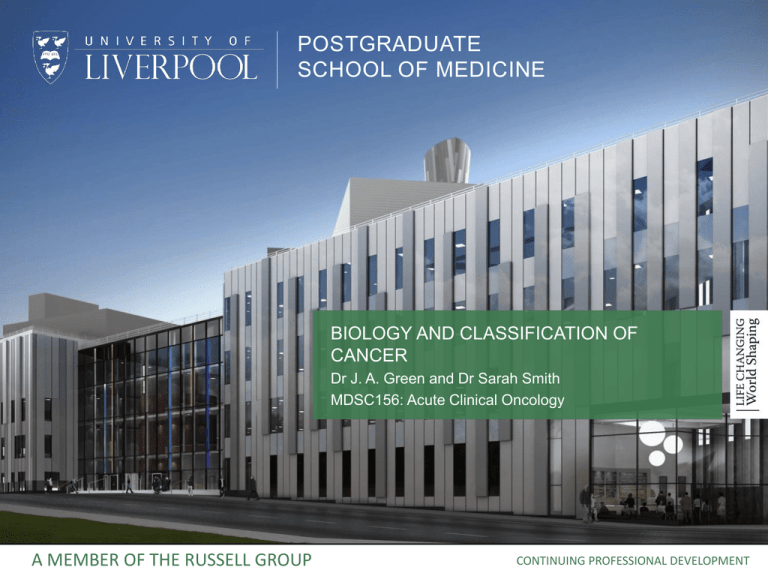
POSTGRADUATE
SCHOOL OF MEDICINE
BIOLOGY AND CLASSIFICATION OF
CANCER
Dr J. A. Green and Dr Sarah Smith
MDSC156: Acute Clinical Oncology
A MEMBER OF THE RUSSELL GROUP
CONTINUING PROFESSIONAL DEVELOPMENT
Biology and Classification of Cancer
2
The Pathway to Cancer
Series of events that fundamentally alter the properties of the cell that lead to:
•
•
•
•
•
Clonal proliferation
Invasion
Pre-malignant states
Accumulation of mutations
Resistance
Nature vs Nurture
i.e. inherited factors vs environmental factors
e.g. BRCA1 vs Radiation
Genetics of Cancer:
•
•
Oncogenes
myc, ras, src, abl, bcl2
Tumor suppressor genes
p53, Rb, APC, MEN1, NF1
Biology and Classification of Cancer
3
Cancer Stem Cell – CD 133 staining
Dr D Hapangama, University of Liverpool
Clevers H . The cancer stem cell: premises promises and challenges. Nat Med, 2011; 12(3):313-319
Biology and Classification of Cancer
4
Characteristics of Neoplasm
Possible Molecular Targets
Self-sufficiency in cell growth
EGFR, platelet-derived GF, MAPkinase, PI3K
Insensitivity to anti-growth signals
SMADs, pRb, cyclin-dependent
kinases, myc
Cell immortality
h-TERT,pRb, p53
Evading apoptosis
Bcl-2, Bax, capsases,Fas, TNF receptor,
insulin GF/PI3K/AKT, mTOR, p53, NFκB, PTEN, Ras
Sustained angiogenesis
VEGF, basic fibroblast GF, integrins (α,
β3 ), thrombospondin-1, HIF-1α
Tissue invasion and metastasis
MMPs, MAP kinase, E-cadherin
Hanahan D, Weinberg RA. The hallmarks of cancer. Cell 2000; 100(1):57-70
Biology and Classification of Cancer
5
Emerging Characteristics of Neoplasm
Deregulating cellular energetics
Avoiding immune destruction
Genome instability and mutation
(an enabling characteristic)
Tumour-promoting inflammation
(an enabling characteristic)
Hanahan D, Weinberg RA. Hallmarks of Cancer: The Next Generation. Cell 2011; 144(1):646-674
Biology and Classification of Cancer
6
Hanahan D, Weinberg RA. Hallmarks of Cancer: The Next Generation. Cell 2011; 144(1):646-674
Biology and Classification of Cancer
Histopathological Confirmation
Example: The Gleason Grading & Scoring System for Prostate Cancer
Grades and scores prostate cancer based upon its microscopic
appearance. The risk of developing metastatic spread increases
with increasing score.
i.e. Gleason score 2-4= 20%, score 5-7 = 40%, scores 8-10 =75%.
The Primary Gleason grade has to be greater than 50% of the total
pattern seen (i.e. the pattern of the majority of the cancer cells observed).
The Secondary Gleason grade has to be less than 50%, but at least
5%, of the pattern of the total cancer cells observed.
The sum of the primary and secondary Gleason grades is shown as the Gleason
score or sum (i.e. primary grade + secondary grade = GS; i.e. 4+3 or 3+4 = GS 7).
7
Biology and Classification of Cancer
8
Well
differentiated
Modified Gleason system.
Cribriform glands are only
seen in patterns 4 and 5.
Poorly formed glands are
also a component of
pattern 4.
Poorly differentiated
Epstein, J. Urol., 2010, An update of
the Gleason grading system, 183 (2),
433-440
Biology and Classification of Cancer
Gleason 3
Gleason 4
4
5
9
Biology and Classification of Cancer
10
Non Small Cell Lung Cancer (NSCLC)
Classifications of Lung Cancer - Histological Subtypes
Lung cancer
Histologic diagnosis
Small Cell
Non- Small Cell
Squamous 33%
NSCLC NOS* 36%
Large Cell
Carcinoma 4%
N.B
1) The remaining 2% of Squamous Carcinomas/non-squamous
level are broncho-alveolar carcinoma and cancer in situ
2) Non-Squamous Carcinomas can be further divided into
EGFR M+ (10-15%) and ALK+ (4%)
* NOS- Not otherwise specified
Travis 2004
Adenocarcinoma 25%
EGFR mutations,
ALK rearrangements
Biology and Classification of Cancer
11
Molecular Staging NSCLC
(a) Normal alveolar epithelium,
negative staining
(b) Normal bronchiolar epithelium,
negative staining
(c) Squamous cell carcinoma,
negative staining
(d) Adenocarcinoma with nuclear
P-ERK staining
(e) Squamous cell carcinoma
with cytoplasmic and moderate
nuclear staining
(f) Adenocarcinoma with nuclear and
extensive cytoplasmic staining.
Vicent et al., BJC, ERK1/2 is activated in non-small-cell lung cancer and associated with advanced tumours, 2004, 90 (5), 1047-1052
Biology and Classification of Cancer
12
Cytology
Exfoliative cytology - spontaneously shed cells in body fluids
•
•
•
•
Urine
CSF
Sputum
Effusions in body cavities (pleura, pericardium, peritoneum)
Pros: non-invasive, fast, limited molecular characterisation
Cons: not always diagnostic or accurate
Note: Where possible tissue biopsy is recommended for definitive diagnosis
Biology and Classification of Cancer
Phases of Cancer Management
Screening
Diagnosis
Prognosis
Treatment options
Personalisation
Survivorship
13
Biology and Classification of Cancer
14
Diagnosis
• Acute oncology component is accelerated
presentation and implementation of diagnostic
pathways.
• Life saving management complicates what would
otherwise be a process evolving over several weeks.
Biology and Classification of Cancer
15
• Diagnosis – recognition of presenting signs, symptoms or
syndromes e.g. SVCO
Superior vena cava obstruction syndrome in a person with bronchogenic carcinoma.
- Note the swelling of his face first thing in the morning (left) and its resolution after being upright
all day (right).
Image of patient with superior vena cava syndrome. Licensed CC BY 2.0 by Herbert, Fred & Hendrik
Biology and Classification of Cancer
16
Staging
• Clinical Staging – clinical manifestations, tumour size, degree of metastasis.
Tests such as CT scans, x-rays and biopsies may be performed.
• Surgical Staging- tumour size, number, sites and degree of metastasis.
• Pathologic Staging- most definitive. Tumour size, number, sites, and degree
of metastasis are determined by pathologic examination of tissue obtained
at surgery.
• Molecular stage – incorporation of biomarkers either in tumour or blood
eg CEA, CA125, Circulating TCs
Biology and Classification of Cancer
17
TNM Classification
Primary Tumour (T)
T0
No evidence of primary tumour
TIS
Carcinoma in situ
T1
Tumour invades submucosa
T2
Tumour invades muscle
T3
Extensive muscle invasion
T4
Tumour invades deep into muscles or directly invades other organs and
structures
Lymph Nodes (N)
N0
No regional nymph node metastases
N1
Metastases in one to three lymph nodes. 1-3cm. Palpable and moveable.
N2
Metastases in four or more lymph nodes. 3-5cm. Firm to hard.
N3
Metastases in any lymph node along course of a major named vascular
trunk. Fixed. Usually greater than 6cm.
Distant Metastasis (M)
M0
No distant metastases
M1
Distant metastases
Biology and Classification of Cancer
Staging Grouping
Stage 0
TIS, N0, M0
Stage I
T1, N0, M0; T2, N0, M0
Stage II
T3, N0, M0, T4, N0, M0
Stage III
Any T, N1, 2. or 3, M0
Stage IV
Any T, any N, M1
Grading System
GX
Grade cannot be assessed
G1
Well-differentiated
G2
Moderately well-differentiated
G3
Poorly differentiated
G4
Undifferentiated
18
Biology and Classification of Cancer
19
Classifying Breast Cancer using TNM
Stage
TNM Classifications
Description
Prognosis
Stage 0
TIS, N0, M0
in situ breast cancer - DCIS
Stage I
T1, N0, M0
Small tumour localised to
the breast
> 85%
Stage IIa
T0-1, N1, M0, or T2, N0, M0
Stage IIb
T2, N1, M0, or T3, N0, M0
2-5cm tumour with no
lymph node
involvement/small tumour
with 1 to > 20 nodes
60-85%
Stage IIIa
T0-2, N2, M0, or T3, N1-2, M0
Stage IIIb
T4, N (any), M0, or T(any), N3, M0
Stage IV
T(any), N(any), M1
Large tumour > 5cm with
+ve nodes/ tumour which
invades the skin or chest or < 50%
fixed & matted lymph nodes
Any distant spread of cancer < 20%
Biology and Classification of Cancer
20
Breast Cancer Subtyping
•
Systematic investigation of gene expression patterns in tumours using
cDNA microarrays, and their correlation to specific features of phenotypic
variation, might provide the basis for improved cancer classification
•
Classification of tumour based on gene expression patterns can be used as
a prognostic marker
•
Indication of potential relapse in patients
•
Survival in patients
Biology and Classification of Cancer
Breast Cancer Subtyping
RNA profiling
Her2 +ve
Luminal A
Luminal B
Triple negative/
Basal
Normal like
21
Biology and Classification of Cancer
22
Molecular Profiling
The same gene / signal transduction pathways can be affected within the same tumour
•
Therapeutic target
•
Personalised treatment
Profiling tumour gene expression can affect prognosis and determine patient treatment
•
Specific mutations can indicate the progression of specific carcinomas
i.e. EGRF activating mutations in NSCLC
•
Can indicate drug resistance or treatment failure
i.e. EML4-ALK mutations can suggest crizotinib resistance
•
Tumour genetic heterogeneity might provide a tumours vulnerability
i.e. Presentation of tumour neoantigens to the immune system
Biology and Classification of Cancer
23
Mutation spectra across endometrial carcinomas
G Getz et al. Nature 497, 67-73 (2013)
Biology and Classification of Cancer
24
Summary
•
Various classification systems by tumour type
•
Tumour subtype becoming more commonly based on histology
•
•
E.g. ovarian cancer serous, mucinous, clear, lung – squamous/nonsquamous
Companion biomarkers e.g.
•
•
•
•
ER,PR,HER2+ and triple negative breast cancer
kras status in colorectal cancer
EGFR mutation positive NSCLC
Grade less accurate for some tumour types
•
i.e. sarcomas
Biology and Classification of Cancer
25
References
•
Clevers H . The cancer stem cell: premises promises and challenges. Nat Med,
2011; 12(3):313-319
•
Hanahan D, Weinberg RA. The hallmarks of cancer. Cell 2000; 100(1):57-70
•
Hanahan D, Weinberg RA. Hallmarks of Cancer: The Next Generation. Cell 2011;
144(1):646-674
•
Epstein, J. Urol., 2010, An update of the Gleason grading system, 183 (2), 433-440
•
Travis 2004
•
Vicent et al., BJC, ERK1/2 is activated in non-small-cell lung cancer and associated
with advanced tumours, 2004, 90 (5), 1047-1052
•
Sorlie PNAS 2001
•
G Getz et al. Nature 497, 67-73 (2013)
FACULTY OF HEALTH & LIFE SCIENCES – CPD
Institute for Learning & Teaching
Faculty of Health & Life Sciences
Room 2.16A, 4th Floor
Thompson Yates Building
Brownlow Hill
Liverpool
L69 3GB
www.liv.ac.uk/learning-and-teaching/cpd
A MEMBER OF THE RUSSELL GROUP












